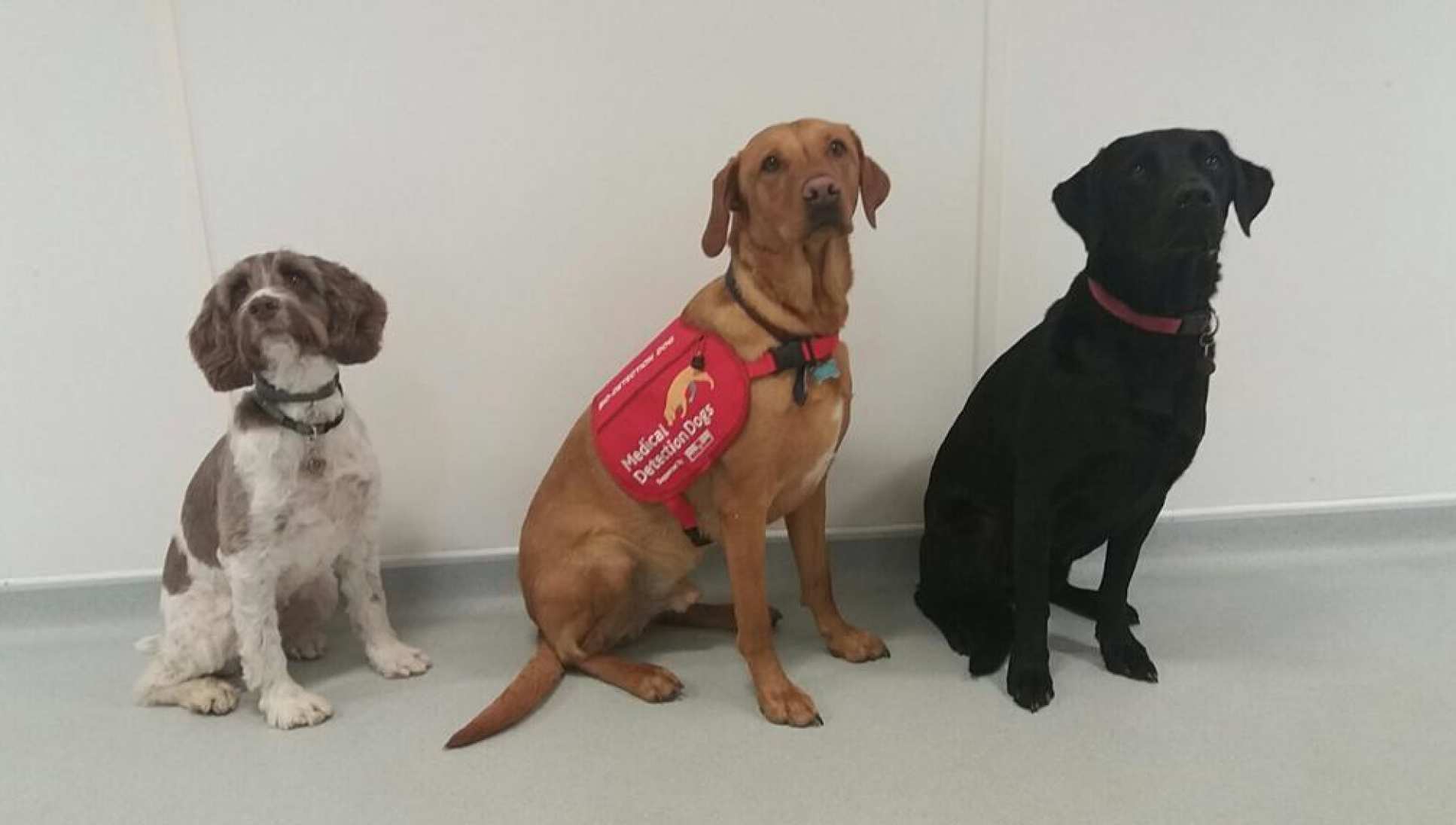Trained Sniffer Dogs Can Detect Key CF Bacteria, Study Shows

Three of the medical detection dogs (Left to right, Lizzie, Flint and Oakley). Photo credit: Medical Detection Dogs
Trained sniffer dogs are able to detect Pseudomonas aeruginosa, the most common bacteria found in people with cystic fibrosis (CF), in liquid cultures even at very low concentrations, a study shows.
This potentially could be useful for detecting infections earlier in CF patients — and without the need for more invasive tests, researchers say.
Findings from the “Training dogs to differentiate Pseudomonas aeruginosa from other cystic fibrosis bacterial pathogens: not to be sniffed at?” study were published in the European Respiratory Journal.
Recurrent bacterial infections are the most common complication associated with CF, with the bacteria Pseudomonas aeruginosa estimated to affect 60% of patients. P. aeruginosa bacteria can resist the action of both antibiotics and an individual’s immune system. Chronic infection with the bacteria in people with CF is linked to pulmonary exacerbation and lung function decline.
Early detection of the infection is key, so that treatment is administered quickly, clinicians note. However, available diagnostic tests lack sensitivity and are time consuming.
Testing for P. aeruginosa is currently done through sputum samples from adults, and on cough or throat swabs in children with CF. However, these tests are not reliable, as infection may be missed or even mistaken by other bacteria. Alternatives like sputum induction and bronchoalveolar lavage are time-consuming and invasive, and therefore not possible for use as a routine procedure.
Researchers therefore began exploring the possibility of detecting P. aeruginosa in breath samples. However, the tests developed thus far have not been sufficient to differentiate infected from non-infected patients.
Want to learn more about the latest research in Cystic Fibrosis? Ask your questions in our research forum.
In this work, researchers at the Imperial College London and Royal Brompton Hospital, in the U.K., successfully trained dogs to detect P. aeruginosa in cultured liquid samples.
For training, the sniffer dogs were presented with the liquid used to grow the bacteria (called supernatant) or control sterile liquid in a random order. After sniffing, if the dog detected P. aeruginosa, it would stop or sit. A correct detection was rewarded with a click sound and food reward.
Researchers evaluated the dogs’ accuracy in detecting P. aeruginosa (sensitivity) and their ability to correctly identify and distinguish P. aeruginosa from other bacteria (specificity).
They presented the dogs with P. aeruginosa samples and small quantities from other familiar bacteria strains, namely Staphylococcus aureus and Moraxella catarrhalis.
The dogs were able to correctly detect P. aeruginosa with a 94.2% sensitivity and a 98.5% specificity. In a similar experiment using other bacteria strains unfamiliar to the dogs, the animals were still able to correctly identify P. aeruginosa in more than 90% of the cases.
The team also tested whether sniffer dogs could identify very small numbers of P. aeruginosa by considerably diluting the samples.
Results showed that even after diluting the samples by 1,000 times, the dogs still identified P. aeruginosa with a sensitivity and specificity higher than 90%. Moreover, trained dogs also detected the bacteria when it was mixed with other bacteria strains in more than 80% of cases.
“In this series of pilot studies, we have confirmed that, following training, dogs can detect the odour of Pseudomonas aeruginosa in broth supernatants with high levels of sensitivity, distinguishing them from other bacteria commonly encountered in the CF lung,” the researchers said.
The team believes that trained dogs could potentially be a more sensitive, and more affordable method for screening for infections in people with CF.
“Advanced technology to detect infections, for example in breath, has proved difficult so far. The successful training of the dogs on cultured samples will now be used as the foundation for testing patient samples directly,” Jane Davies, professor at the National Heart and Lung Institute at Imperial College London, and the study’s first author, said in a press release written by Ryan O’Hare.
“People with CF could ultimately monitor their lung infections from home by sending in samples for the dogs to check,” Davies added.
The charity Medical Detection Dogs was involved in this project, which was funded by the Cystic Fibrosis Trust.
“Pseudomonas is a condition that affects thousands of people each year in the U.K. alone. I can assure them that Medical Detection Dogs is working very hard to find effective, affordable and sustainable ways to manage their condition,” said Claire Guest, chief executive and co-founder of Medical Detection Dogs, and a study author.
“The findings of this world-first study … are yet another indicator of [the dogs’] remarkable contribution to saving human lives,” Guest added.
According to Janet Allen, director of strategic innovation at the Cystic Fibrosis Trust, a “quick and easy way of detecting Pseudomonas would make a massive difference to people with cystic fibrosis and their families.
“We’re delighted to fund the next steps of this work … so we can build on this work and help people with cystic fibrosis live longer, healthier lives,” Allen said.








